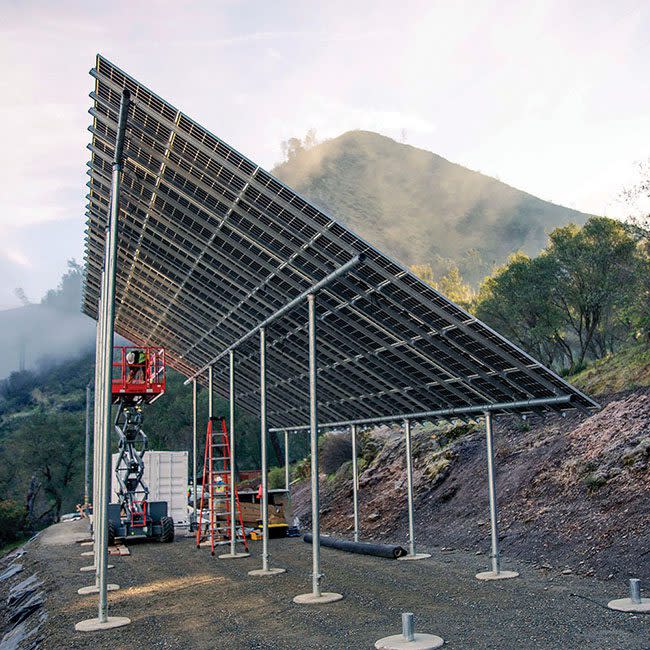PG&E Recognized for Remote Grid Program

Pacific Gas and Electric Co. (PG&E) and its remote grid program received an honorable mention in the Energy category of Fast Company's 2024 World Changing Ideas Awards. Winners were announced on May 14, highlighting fresh sustainability initiatives, cutting-edge artificial intelligence (AI) developments, and other creative projects that are helping mold the world. PG&E is one of the first energy companies in North America to deploy standalone power systems as an alternative customer service offering to electricity provided through traditional grid infrastructure. Throughout PG&E’s 70,000-square-mile Northern and Central California service area, pockets of remote customers are served via long electric distribution lines that in many cases traverse high-fire-risk areas. Replacing these overhead powerlines with a reliable and low-carbon local energy source is an innovative option that, in many cases, is preferred for serving customers at the edges of the grid. Remote grids operate independently from the larger electric grid that delivers energy throughout the state, and they allow PG&E to remove overhead powerlines, significantly reducing wildfire risk and service interruptions.
World Changing Ideas
This year's World Changing Ideas Awards showcase 50 winners, 127 finalists, and 172 honorable mentions—with health, education, energy, and AI among the most popular categories. A panel of Fast Company editors and reporters selected winners from a pool of more than 1,300 entries from across the globe, including the Republic of Korea, Brazil, and Madagascar. "Recognition of PG&E's remote grid program as a Fast Company 2024 World Changing Idea validates our commitment to deploy energy innovations at greater speed and deliver the best possible customer experiences," said Mike Delaney, vice president, Utility Partnerships and Innovation, PG&E. "PG&E is where innovation goes to scale and where innovators come to grow, and I want to thank our program collaborators, our regulators and state agencies, our customers, and our co-workers who made the idea of widely deployed remote grids a reality through breakthrough thinking and swift execution." "I was struck this year by the global sweep of the honorees," Fast Company Editor-in-Chief Brendan Vaughan said. "It's endlessly inspiring to see how the world is coming together to devise inventive solutions to our most challenging problems. We need ideas from everywhere, and this year's World Changing Ideas Awards are an extraordinary encapsulation of the innovation and creativity that is so abundant around the globe."
Scaling Remote Grids: From Briceburg to Pepperwood and Beyond
PG&E deployed its first remote grid in 2021 in Briceburg, California, near Yosemite National Park. The Briceburg remote grid has been a testament to resilience, maintaining superior power reliability with almost no downtime for the five customers it has served since June 2021. The standalone power system, which replaced 1.3 miles of overhead distribution lines, has generated more than 90% of its power from solar energy. Backup generators support redundancy and power generation during winter months when solar generation is lower due to shorter days and cloudier weather. The Briceburg system has remained operational throughout several severe weather events over the last few years when nearby customers lost power during fires and winter storms. In November 2023, PG&E deployed its fifth—and first fully renewable—remote grid at Pepperwood Preserve outside Santa Rosa, California. The Pepperwood system is comprised of solar and battery energy storage, and includes energy efficiency upgrades to the property it serves to keep from draining the batteries during periods of no or low solar generation, minimizing the likelihood of a power outage. The new system replaces 0.7 miles of overhead distribution line, eliminating the associated wildfire risk, and complementing Pepperwood's own initiatives in wildfire resilience. Today, PG&E celebrates the continued expansion of its remote grid program, with a half dozen new systems being built in 2024, allowing PG&E to remove an additional six miles of overhead power lines while enabling six customers to continue receiving safe, reliable, affordable, low-carbon, and wireless energy. PG&E has worked with Potelco Inc. and Grass Valley, California–based BoxPower to design and build its growing remote grid fleet. Richmond, California–based New Sun Road provides the remote monitoring and control platform for managing PG&E's remote grids. These companies represent a growing ecosystem of microgrid vendors working alongside PG&E to design, deploy, and scale standalone power systems as a service offering. Including the new systems to be deployed in the coming months, PG&E will soon reach up to 12 total remote grids powering 18 customers while removing nearly 13 miles of overhead electric distribution lines at the grid edge in high-fire-threat areas. PG&E has identified many additional locations where remote grids may be the most effective way of reducing wildfire risk and improving electric reliability, with additional sites either in development or being assessed in Butte, Glenn, and Tehama counties, among others. Remote grids are primarily identified, designed, and deployed as part of PG&E's system hardening work, which prioritizes hardening powerlines based on elevated wildfire risk and geographic considerations. In addition to remote grids, PG&E's system hardening efforts include undergrounding, installing stronger and more resilient poles, and replacing bare powerlines with larger, covered lines. —POWER edited this content, which was contributed by a public relations firm representing PG&E.

 Yahoo Finance
Yahoo Finance 